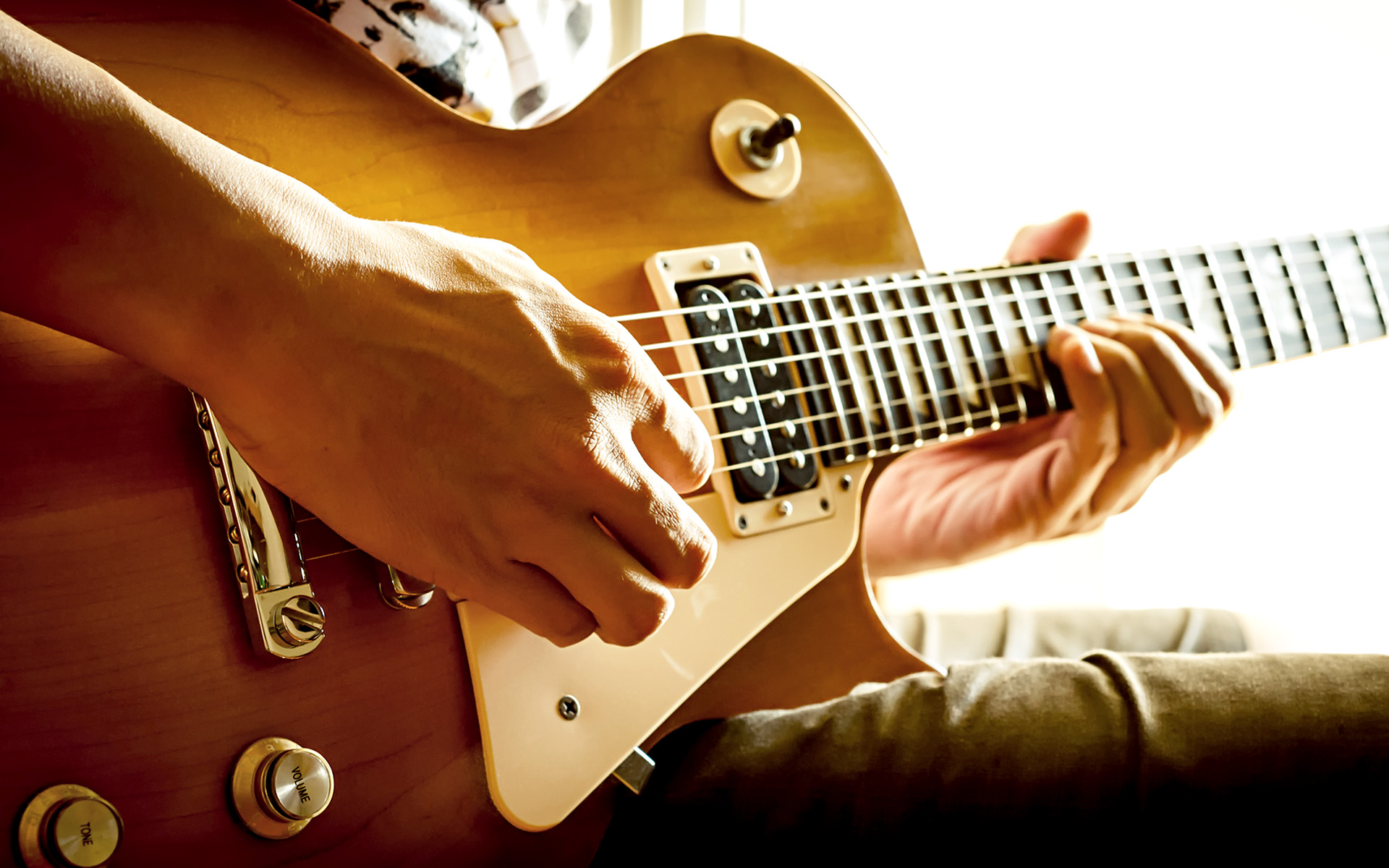The following information on guitar scales is excerpted from the Berklee Online course Guitar Scales 101, written by Larry Baione, and currently enrolling.
Studying guitar scales is fundamental to the mastery of the instrument, no matter what style you play. Learning scales benefits our technique and our knowledge and navigation on the instrument. It helps us organize that ambiguous guitar fretboard. Anyone can easily see the C major scale on the piano, but it is a different story on the guitar. Simply stated, studying guitar scales gives us knowledge of the fretboard and develops our technique.
In these video tutorials, you’ll learn the beginner steps to start learning your guitar scales, from how to hold the guitar, how to play the C major scale, how to play the modes, and how to play in time.
How to Hold, Fret, and Pick the Guitar
First, let’s discuss some essential guitar techniques, focusing on tips that have been effective for students at Berklee Online. Always use a strap to ensure the guitar remains in the same position, whether you’re sitting or standing. This helps you know where everything is so you don’t need to look at your hands as much.
Additionally, it’s crucial to hold the guitar in a way that feels natural and avoids potential strain or shoulder problems. In the video, Larry prefers to hold the guitar slightly slanted, mimicking a classical sitting posture, with the left leg or right leg crossed.
When it comes to finger positioning on the fretboard, keep the fingers flat across the strings and spread out, using the tips of your fingers to fret. Keep the thumb flat behind the neck of the guitar and use the fatty part of your thumb, not the tip where the bone is, as that will become pretty sore if you press on that for an extended period of time. You can use your thumb as a fulcrum to switch around and stretch for different notes.
On the picking side, try using the technique of rest strokes, where the pick rests on the next string after a stroke. Check out the video demonstration to see what this looks like. This method is akin to the classical guitar technique and helps you maintain control and achieve a better sound quality.
Finally, always make sure your guitar is in tune before playing. A tuner is an indispensable tool, and Berklee Online students are always asked to tune their guitars as soon as they start their practice sessions.
C Major Scale on Guitar
We begin with the C major scale, known for its simplicity, as it includes all the white notes on the piano. To play the C major scale on guitar, we’ll start with the easiest way on a single string. Start on the second string and follow the pattern: whole step, whole step, half step, whole step, whole step, whole step, half step. Of course, whole steps are two half steps and each fret is a half step. You can play a major scale from any note by using the WWHWWWH formula.
Then we can move into what is called first, or open position, because we use open strings. The index finger will be on the first fret, middle finger on the second, ring finger on the third, and pinkie on the fourth. Watch along in the video to learn the pattern that creates the C scale.
Just like first position, second position starts with the index finger on the second fret, middle finger on the third, ring finger on the fourth, and pinkie on the fifth. It involves the same notes as our open position or first position and by not using any open strings, this makes this fingering movable.
The goal is to learn some of these fingerings so that you don’t have to worry about where your fingers are, or if you’re in the right position. This technique is crucial for playing legato and producing a smooth and connected sound.
Modes of the Major Scale on Guitar
Here we’re exploring the modes of the major scale, starting from the “parent scale,” also known as the “relative scale.” The exercise involves playing in a single key while beginning on different notes, resulting in different modes.
We start with the Ionian mode from the root, followed by Dorian from the 2nd degree, Phrygian from the 3rd, Lydian from the 4th, Mixolydian from the 5th, Aeolian from the 6th, and Locrian from the 7th. This sequence is demonstrated within one octave, such as C to C, D to D, and so on. This will help you understand the different tonalities and characteristics of each mode within a consistent key.
For even more background on the major modes, Kim Perlak explains in her Guitar Fundamentals course:
There are seven different notes in the major scale, and seven movable fingering patterns that begin on each. From one perspective, when you play the fingering for each mode on the fretboard you are playing seven different fingerings of the major scale. This allows you to play every mode in every place on the fretboard! From a different perspective, each fingering tonicizes its start note—creating the specific color and mood of that mode.
Learn the most common fingerings for each major scale mode, identified by their starting scale degree. These are shown here in C major, and they can be played in all major keys.
- Ionian, from the 1st degree: C D E F G A B C
- Dorian, from the 2nd degree: D E F G A B C D
- Phyrigian, from the 3rd degree: E F G A B C D E
- Lydian, from the 4th degree: F G A B C D E F
- Mixolydian, from the 5th degree: G A B C D E F G
- Aeolian, from the 6th degree: A B C D E F G A
- Locrian, from the 7th degree: B C D E F G A B
Practicing Tempo
Practicing scales with a metronome is a great way to develop your timing and listening skills. It helps musicians play evenly and maintain tempo, which is crucial when performing in a band setting where you need to be tuned in to your own part, as well as everyone else’s. Start by playing whole notes on a C major scale in the second position, playing slowly to master control and precision before attempting faster tempos. This slow practice also strengthens the left hand and fosters a smooth, legato style where notes connect fluidly. Once you get a hang of whole notes on the C major scale, go on to try half notes and eighth notes. Then you could try the G major scale.
View the entire YouTube playlist on Guitar Scales
Mastering guitar scales is a foundational skill for any guitarist, regardless of musical style. By understanding and practicing scales, you can gain greater control over your instrument, improve your technical proficiency, and develop a more intuitive grasp of music theory. Whether you’re just beginning your guitar journey or looking to deepen your skills, incorporating these techniques and insights into your practice routine can help you become a more confident and versatile player.
STUDY GUITAR WITH BERKLEE ONLINE












